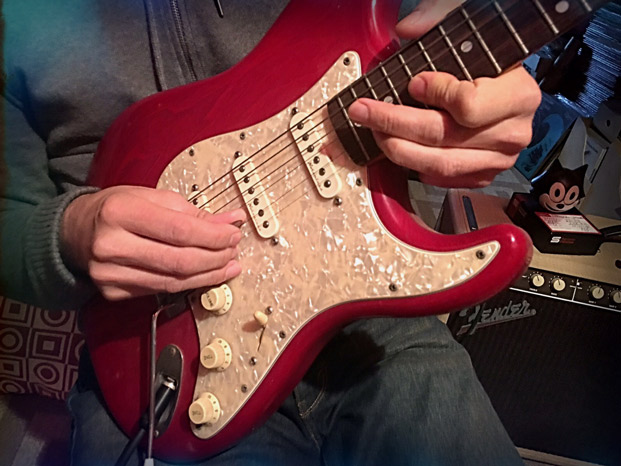Sick Guitar Tricks: How to Create Warbles, Whinnys and Other Cool Effects
Have you ever heard an ungodly whoop or cry emerging from another guitarist’s ax and wondered how the heck to do it? If so, then this lesson is for you.

Every instrument has its quirks, and the guitar is no exception.
In the hands of a skilled player, it can produce sounds that aren’t possible on any other music-making device—sounds that catch the listener’s ear and at the same time leave aspiring guitarists dumbfounded.
Have you ever heard some ungodly whoop or cry emerging from another guitarist’s ax and wondered how the heck to do it? If so, then this lesson is for you.
What follows is a guided tour of some wild techniques unique to the guitar—techniques that should elicit from your peers the same kind of slack-jawed looks you made the first time you heard the true masters of the trade perform them. And if the names Eddie Van Halen, John Petrucci, Kirk Hammett, Joe Satriani and Steve Vai mean anything to you, you’ll know exactly what we mean.
TRICK HARMONICS
Most commonly played at the 5th, 7th and 12th frets, natural harmonics can actually be found all along a string’s length. FIGURE 1A is played by simultaneously trilling with your fret hand and gradually brushing the side of your index finger along the 3rd string to sound a variety of different harmonics. Checkout Vernon Reid’s work on Living Colour’s “Fight the Fight” for a similar lick. In FIGURE 1B, use your fret-hand’s index finger to sound various harmonics on the E string. Some (3.1, 2.6, etc.) are found in between the frets.

FLICK OF THE SWITCH
All the latest guitar news, interviews, lessons, reviews, deals and more, direct to your inbox!
Inspired by Eddie Van Halen, FIGURE 2 requires a guitar with Les Paul–style electronics—that is, separate volume controls for the neck and bridge pickups. First, set one of your pickup’s volume level to 10 and the other to zero. After fretting the initial note, toggle back and forth between the two pickups in the indicated rhythm to create a tremolo-like effect. Sound all the notes by hammering onto them with your fret hand.
AXE-OTICA

If you have a flair for the exotic. FIGURE 3 will be right up your alley. Each note in the figure is preceded by a brief tap on the same string, one octave higher, which yields a koto-like effect. (A koto is a Japanese instrument that usually has 12 strings.) Pre-fret each lower note, and use your pick-hand’s middle or index finger for each grace-note tap/pull-off. Be sure to apply enough pressure that the grace notes sound at volumes equal with the notes below, and strive for evenness throughout the figure.

GETTING NUTTY
The length of string behind the guitar’s nut can also be used for some tricks. Inspired by Van Halen’s “Runnin’ with the Devil,” FIGURE 4A is capped off with a backward rake behind the nut, which creates a high-pitched chime-like sound. Meanwhile, in FIGURE 4B, a behind-the-nut bend evokes the twangy sound of a pedal steel. Here, after strumming the G chord in measure 2, execute the bend by pressing down on the 2nd string with your pick-hand’s middle finger. Check out Jerry Donahue’s work with the Hellecasters for some more behind-the-nut madness.
GOING OVERBOARD

We’ve all, when playing a ripping solo, accidentally yanked the high E sting off the fretboard and been rewarded with an undesirable sound. Well, who says this can’t be turned into a cool thing? As a matter of fact, the piercing scream in Kirk Hammett’s “Master of Puppets” solo was achieved by this bit of happenstance. FIGURE 5 shows two examples of the technique. On the second beat, play the 9th-fret C#, then yank it off the fretboard and release it in the indicated rhythm, just as you would in a conventional bend/release. Bar 2 contains a similar move on the 1st string with the note E.
BIRD SONGS

The tremolo-bar warble, or flutter, is best achieved on a guitar with a Floyd Rose–style whammy. FIGURE 6 is inspired by John Petrucci’s playing on Dream Theater’s “Under the Glass Moon.” Begin the figure by pointing your tremolo bar away from the fretboard. After picking each indicated note in bars 1, 3 and 4, slap the tip of the bar, causing a slight increase in pitch. This will be followed by a fluttering sound as the bar returns to its resting position.
PET SOUNDS

Let’s cap off our workout with two more bar tricks. FIGURE 7A is a version of Eddie Van Halen’s infamous “horse whinny.” Once you reach the bottom of the initial open-string dive bomb, lightly touch the string with your fret-hand’s 1st finger to sound the harmonic. Then gradually release the bar and use it to add vibrato. FIGURE 7B introduces one of Joe Satriani’s bar tricks. On a guitar fitted with single-coil pickups that have exposed pole pieces, dive bomb until the strings go slack, allowing the G string to touch one of the poles. Then release the bar to produce that sweet “hiccup” sound.

Since 1980, Guitar World has been the ultimate resource for guitarists. Whether you want to learn the techniques employed by your guitar heroes, read about their latest projects or simply need to know which guitar is the right one to buy, Guitar World is the place to look.

